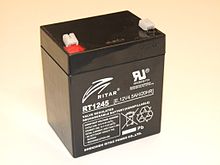
A valve regulated lead–acid (VRLA) battery, commonly known as a sealed lead–acid (SLA) battery,[1] is a type of lead–acid battery characterized by a limited amount of electrolyte ("starved" electrolyte) absorbed in a plate separator or formed into a gel; proportioning of the negative and positive plates so that oxygen recombination is facilitated within the cell; and the presence of a relief valve that retains the battery contents independent of the position of the cells.[2]
There are two primary types of VRLA batteries, absorbent glass mat (AGM) and gel cell (gel battery).[3] Gel cells add silica dust to the electrolyte, forming a thick putty-like gel. AGM (absorbent glass mat) batteries feature fiberglass mesh between the battery plates which serves to contain the electrolyte and separate the plates. Both types of VRLA batteries offer advantages and disadvantages compared to flooded vented lead–acid (VLA) batteries or each other.[4]
Due to their construction, the gel cell and AGM types of VRLA can be mounted in any orientation, and do not require constant maintenance. The term "maintenance free" is a misnomer as VRLA batteries still require cleaning and regular functional testing. They are widely used in large portable electrical devices, off-grid power systems and similar roles, where large amounts of storage are needed at a lower cost than other low-maintenance technologies like lithium ion.
- ^ Eismin, Thomas K. (2013). Aircraft Electricity and Electronics (Sixth ed.). McGraw Hill Professional. p. 48. ISBN 978-0071799157.
- ^ Linden, David B.; Reddy, Thomas (2002). "24". Handbook of Batteries Third Edition. McGraw-Hill. ISBN 0-07-135978-8.
- ^ "Exploding Lead Acid Batteries, Mines Safety Bulletin No. 150". Australia: Queensland Government. 2015-10-27. Retrieved 2020-02-17.
- ^ "Selecting the Proper Lead–Acid Technology" (PDF). Trojan Battery Company, California, USA. 2018. Archived (PDF) from the original on 2023-09-29. Retrieved 2023-09-29.